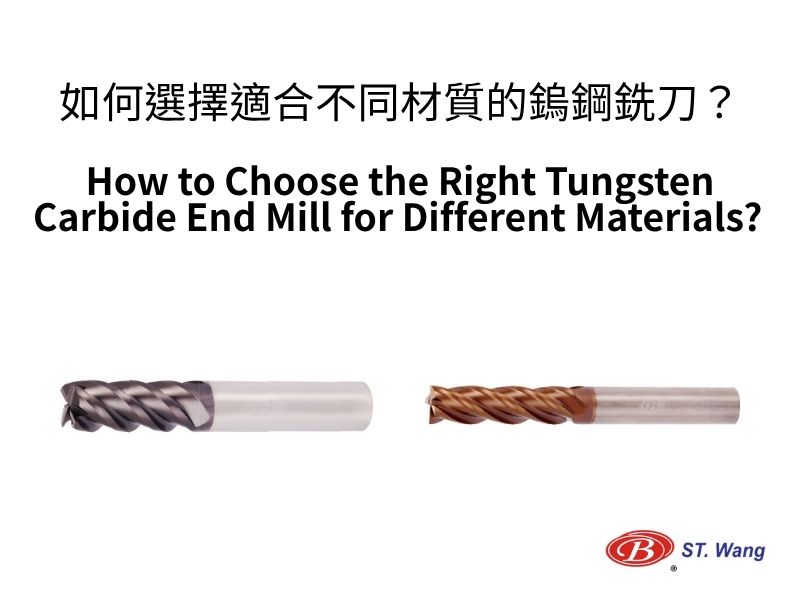
How to Choose the Right Tungsten Carbide End Mill for Different Materials? Let the Experts SHANG TZANG WANG Guide You
In modern manufacturing, tungsten carbide end mills are indispensable tools for cutting and machining. Whether it’s metalworking, mold making, aerospace, or the automotive industry, tungsten carbide end mills play a critical role. As a professional tungsten carbide end mill manufacturer in Taiwan, Stwang Enterprise Co., Ltd. has been committed to providing efficient and durable cutting solutions to customers since its establishment in 1987. Our products include nano powder fine-grain tungsten carbide end mills, indexable drill series, and various specialized tools to meet the machining needs of different materials.
In this article, we will provide a comprehensive guide to selecting tungsten carbide end mills, covering material characteristics, tool selection, common mistakes, and solutions. This will help you improve machining efficiency and reduce production costs.
1. Machining Requirements and Tool Selection for Different Materials
The characteristics of the material being machined directly influence the choice of tools. Below are some common materials, their machining characteristics, and our professional recommendations:
1. Aluminum Alloys
Material Characteristics:
Aluminum alloys have low hardness and high ductility, making them easy to machine. However, during high-speed cutting, chip buildup can occur, affecting surface quality.
Recommended Tools:
- Long-Flute 2-Flute End Mills for Aluminum: Stwang’s aluminum-specific tools use ultra-fine-grain tungsten carbide material, providing high sharpness and excellent chip evacuation performance.
- Coating Recommendation: Use specialized coatings for aluminum (e.g., TiB2) to effectively reduce chip buildup and improve surface finish.
2. Stainless Steel
Material Characteristics:
Stainless steel has high toughness and low thermal conductivity. It tends to harden during machining, requiring tools with excellent wear resistance and heat resistance.
Recommended Tools:
- ST880 Ultra-Fine Grain Tungsten Carbide End Mill: This tool offers exceptional wear resistance, effectively handling the high temperatures and hardening issues associated with stainless steel machining.
- Coating Recommendation: Use TiAlN or AlTiN coatings, which enhance heat resistance and prolong tool life.
3. Carbon Steel and Alloy Steel
Material Characteristics:
Carbon steel and alloy steel have higher hardness and generate significant heat during machining, posing challenges for tool heat resistance and cutting performance.
Recommended Tools:
- Nano Powder Fine-Grain Tungsten Carbide 2-Flute End Mill: Designed for high-hardness materials, this tool provides excellent cutting performance and heat resistance.
- Machining Advice: Use coolant to reduce cutting temperature and prevent premature tool wear.
4. Hard Materials (e.g., Hardened Steel, Tool Steel)
Material Characteristics:
Hard materials have extremely high hardness, requiring tools with exceptional hardness and wear resistance.
Recommended Tools:
- ST880X Ultra-Fine Grain Tungsten Carbide End Mill: Made with ultra-fine-grain tungsten carbide, this tool is designed for machining hard materials and maintains stable cutting performance under high hardness conditions.
- Machining Advice: Use tools with a small helix angle to improve cutting rigidity and apply appropriate cutting parameters to avoid tool damage.
5. Plastics and Composite Materials
Material Characteristics:
Plastics and composites are soft and prone to deformation. Machining requires attention to avoid burrs and overheating.
Recommended Tools:
- Ultra-Fine Grain Tungsten Carbide 3-Flute End Mill: The sharp design of this tool minimizes burrs and heat generation during machining.
- Machining Advice: Control cutting speed and feed rate to ensure machining stability.
2. Avoiding Common Mistakes to Enhance Machining Efficiency
When selecting and using tungsten carbide end mills, many machinists encounter issues due to neglecting critical details. Below are common mistakes and their solutions:
- Ignoring the Importance of Tool Coatings
Mistake: Some users believe coatings have little impact on machining performance and opt for uncoated tools.
Solution: Coatings significantly enhance tool wear resistance and heat resistance. For example, TiB2 coatings are suitable for aluminum machining, while TiAlN coatings are ideal for high-temperature applications. - Incorrect Tool Geometry Selection
Mistake: Overlooking the helix angle, number of flutes, and other design aspects, leading to poor chip evacuation or inadequate cutting performance.
Solution: Aluminum requires tools with a large helix angle, while hard materials need tools with a small helix angle and fewer flutes for improved cutting rigidity. - Not Considering Machining Conditions
Mistake: Using low-speed tools for high-speed machining or vice versa.
Solution: Choose tools that match the spindle speed range and machining requirements of your machine. For example, high-speed machining demands high-speed-specific tools. - Overemphasis on Low Cost
Mistake: Opting for inexpensive but underperforming tools, resulting in reduced machining efficiency and increased tool replacement frequency.
Solution: Invest in high-quality tungsten carbide end mills with good cost-performance ratios. While the initial cost may be higher, they reduce long-term machining costs.
3. Stwang’s Professional Advantages
As a professional cutting tool manufacturer, Stwang Enterprise Co., Ltd. has over 35 years of experience in providing high-quality cutting solutions. Our product designs not only address the machining needs of various materials but also emphasize tool durability and machining efficiency.
- Customized Tool Design: We offer tailored tool design solutions based on the machining materials and needs of our customers, ensuring optimal machining results.
- Professional Technical Consultation: Our technical team provides expert advice on machining issues, helping customers solve real-world production challenges.
- High-Quality Materials and Coating Technology: We use high-quality fine-grain tungsten carbide materials combined with advanced coating technologies to ensure superior tool performance in any machining environment.
Conclusion
Choosing the right tungsten carbide end mill for different materials is a combination of technical knowledge and experience. By understanding material characteristics, selecting the correct tools, and leveraging Stwang’s professional expertise, you can enhance machining efficiency and reduce production costs. As a leading brand in Taiwan’s tungsten carbide end mill industry, we look forward to working with you to create greater machining value. For more information or technical support, please feel free to contact us, and we will be deliglighted to assist you!